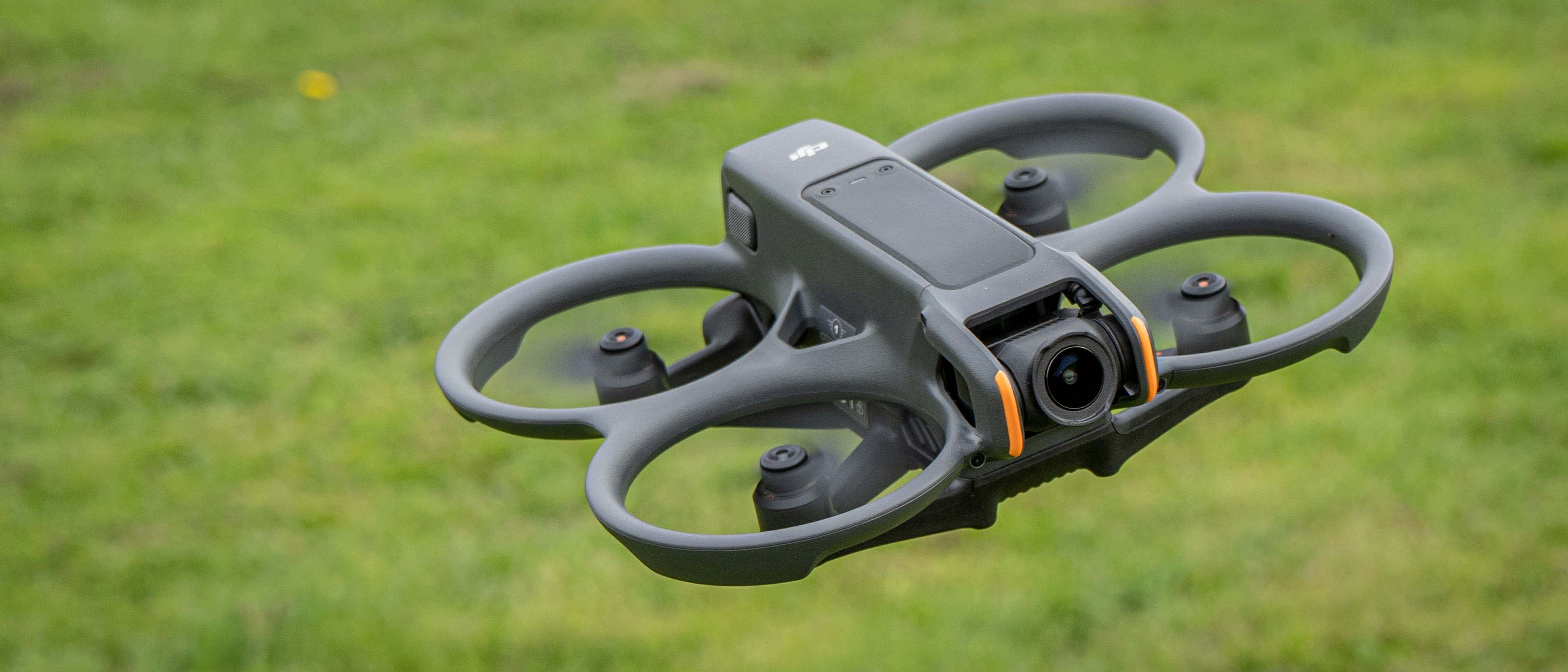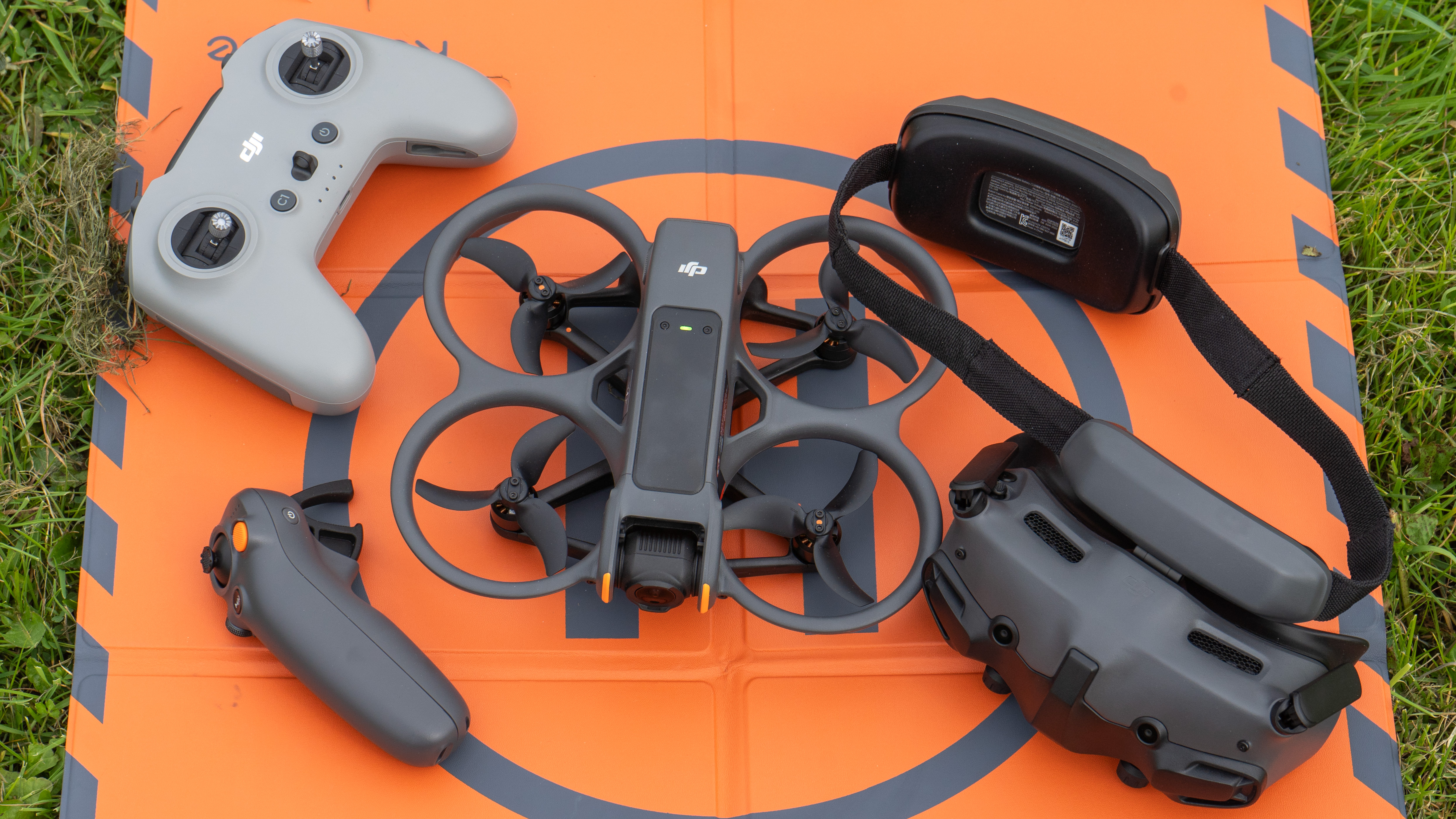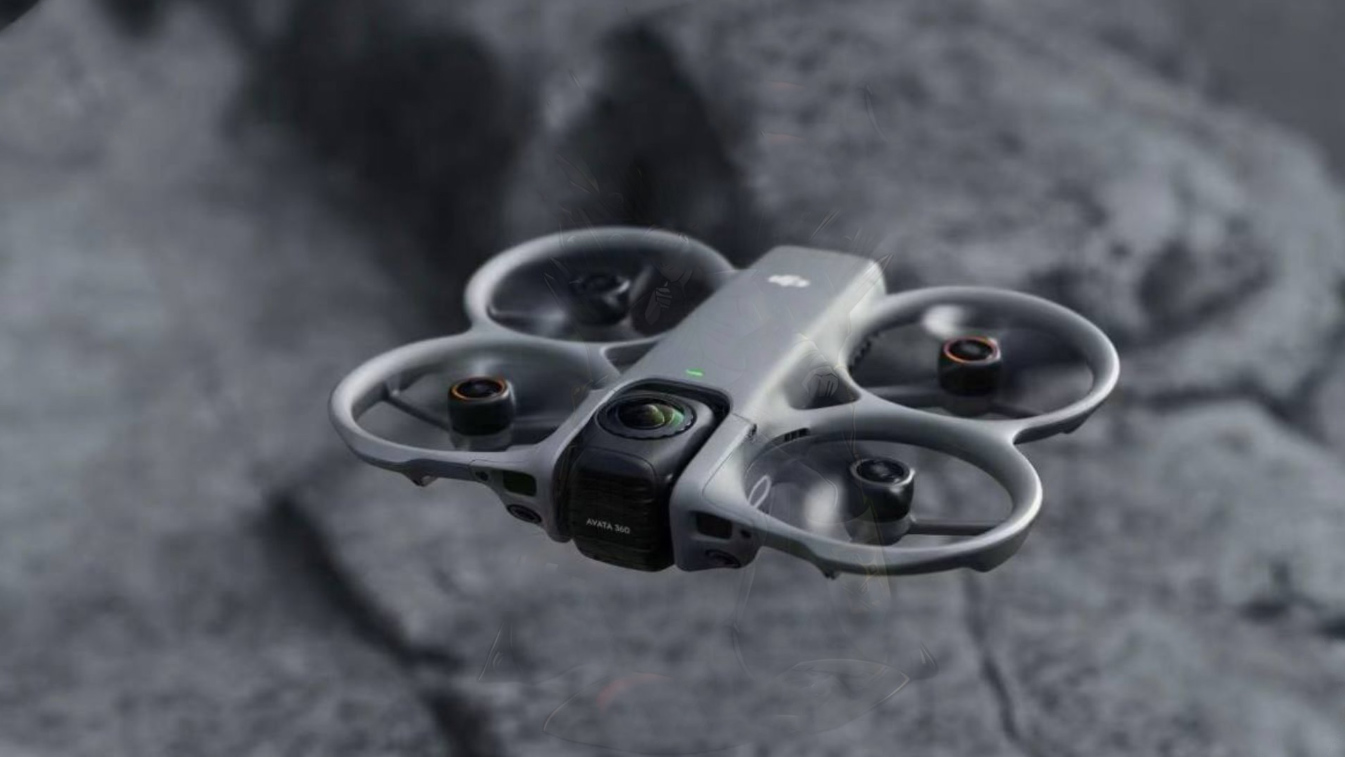Digital Camera World Verdict
The Avata 2 takes the best elements of its predecessor and refines them to a point it's hard to beat. Unlike traditional FPV drones, the Avata is about as safe as possible and unbelievably easy to pick up and get going. It soon starts to feel like an extension of yourself. The menus could stand to be a little clearer in places, but this would still be my pick of FPV drones by a mile.
Pros
- +
1/1.3-image sensor center of excellent camera
- +
Robust and improved airframe design
- +
Easy Acro lets you flip and roll without practice
- +
Live feed can be shared to nearby viewers
- +
Generous 48GB built into drone to record
Cons
- -
If you need steady images, you'll need another drone
- -
Some elements tricky to clean
- -
It's above 250g
- -
FPV traditionalists won't enjoy it
Why you can trust Digital Camera World
When I reviewed the first DJI Avata I was impressed, not just by the drone but the whole package. By adopting the 'cinewhoop' style DJI made clear they were aiming for a drone which could capture stunning imagery – at least while in motion – and by fun, but have physical safeguards.
Specs
Build and Handling
(including RC Motion 3)
FPV Remote Controller 3
DJI Goggles 3
Performance
Sample Video
Overall Verdict
Alternatives
The device lacked some refinements, though, so it didn't earn all five stars. For one thing, it had 5-blade rotors and the MicroSD port was inside one of the vents, making it incredibly fiddly to change the card. If the Avata was about revolution for DJI's FPV devices, the Avata 2 seems to be about the refinement of a concept. A very thorough refinement.
At the same time as the drone, all the related devices have seen a very thorough re-design too. DJI have launched the Avata 2 alongside a new hand controller – RC Motion 3 – and new Goggles (as well as a minor revision to the optional stick controller for classic manual flight.
What we're seeing is an FPV drone which addresses all the issues raised last time (and there weren't that many, in truth – check my original DJI Avata review). It is even refined in ways I didn't expect, like overall volume!
DJI Avata 2: Specs
| Weight | 385g (on my scales) |
| Battery Life | Theory: 23mins / My tests: 8-ish of hard flying |
| Max recording resolutions | 4K at 60fps / 2.7K at 120fps |
| Sensor size | 1/1.3-inch |
| FOV / lens | 155-degrees (13.1mm EFL) / f/2.8 |
| Range | 13km (USA), 10km (Europe/UK) using DJI O4 |
| Latency | 24ms at 1080P / 100fps |
| Storage | 46GB storage + Micro SD card slot |
| Accessories tested with | Goggles 3 (weight 471g) |
DJI Avata 2: Price
The Avata 2 launch price – with Goggles 3 and RC Motion 3 – is $999 / £879, while the Fly More Combo (Three Battery) – the version I tested which has three batteries, a charging hub and a sling bag – is listed at $1199 / £1,049. (In both cases the FPV Remote Controller 3 is an optional extra at $149 / £139, while a set of ND filters is $69 / £59).
UPDATE: As of June 2024 a firmware update means it is now possible to use the drone with the older Goggles 2 and RC Motion 2, making the drone-only option a route for some (but remember that the batteries aren't the same size as the Avata (1).
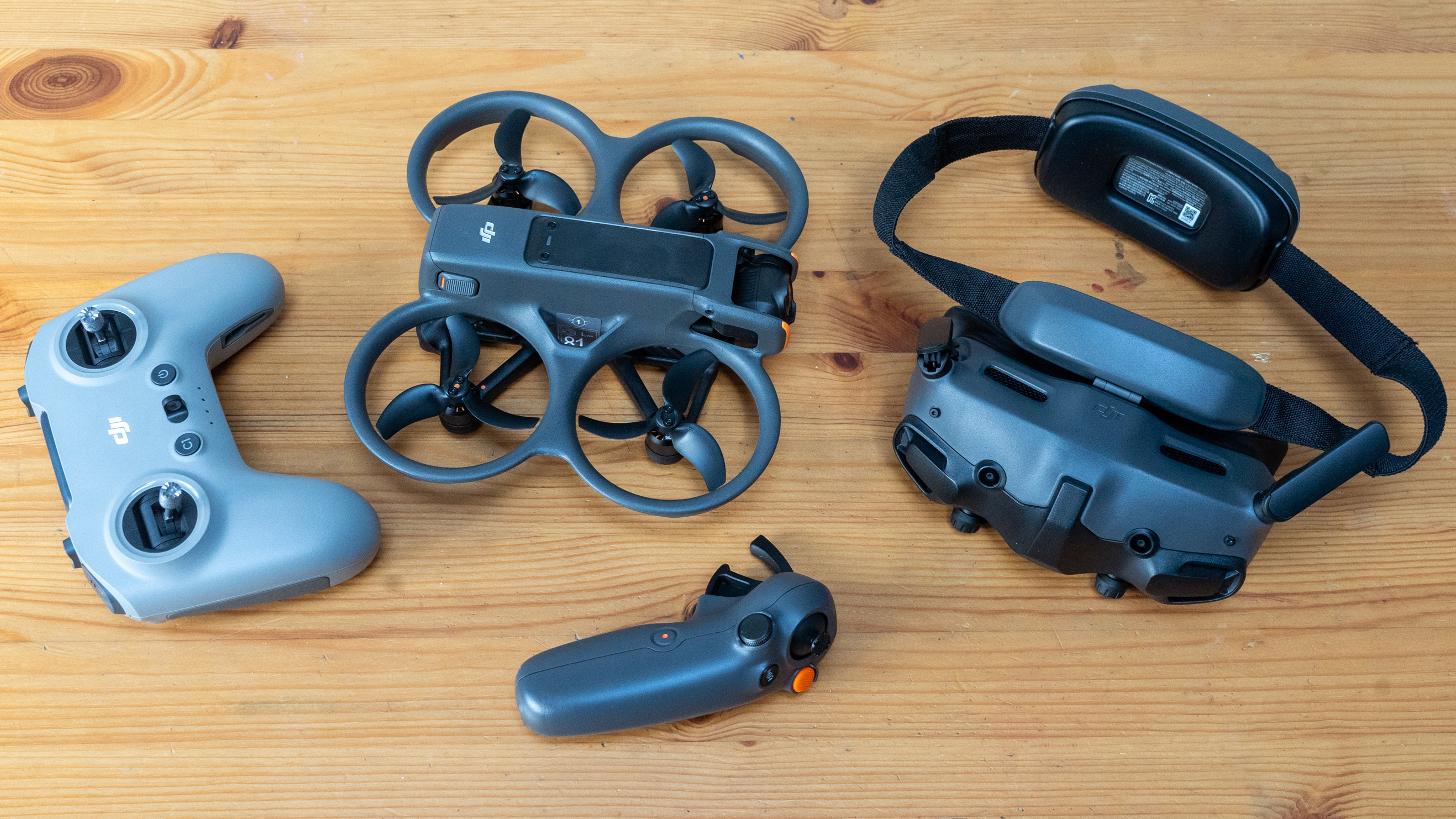
Build and Handling
There's no arguing with how much better the Avata 2 looks than its predecessor. The striking orange stripes at the front could distract you into thinking that's the only change but, in reality, nothing is the same except the cinewhoop concept. Cinewhoop, by the way, is the frame style; it's an FPV drone but still a bit better suited to good video, with propellor ducts that act as guards. They fly better than classic FPV drones at slower speeds, and are safer, even indoors.
The best camera deals, reviews, product advice, and unmissable photography news, direct to your inbox!
Gone is the Avata 1's structural frame; now the battery is fully encased in a smooth, elegant fuselage which is fronted with the camera. The motor's connection to the frame sits below the props (and their guards) which affords the design opportunity to put an easy-to-access port, with a cover, for a Micro SD card and a USB-C socket. The drone can charge a single battery inside, too, though of course a charging hub is an option.
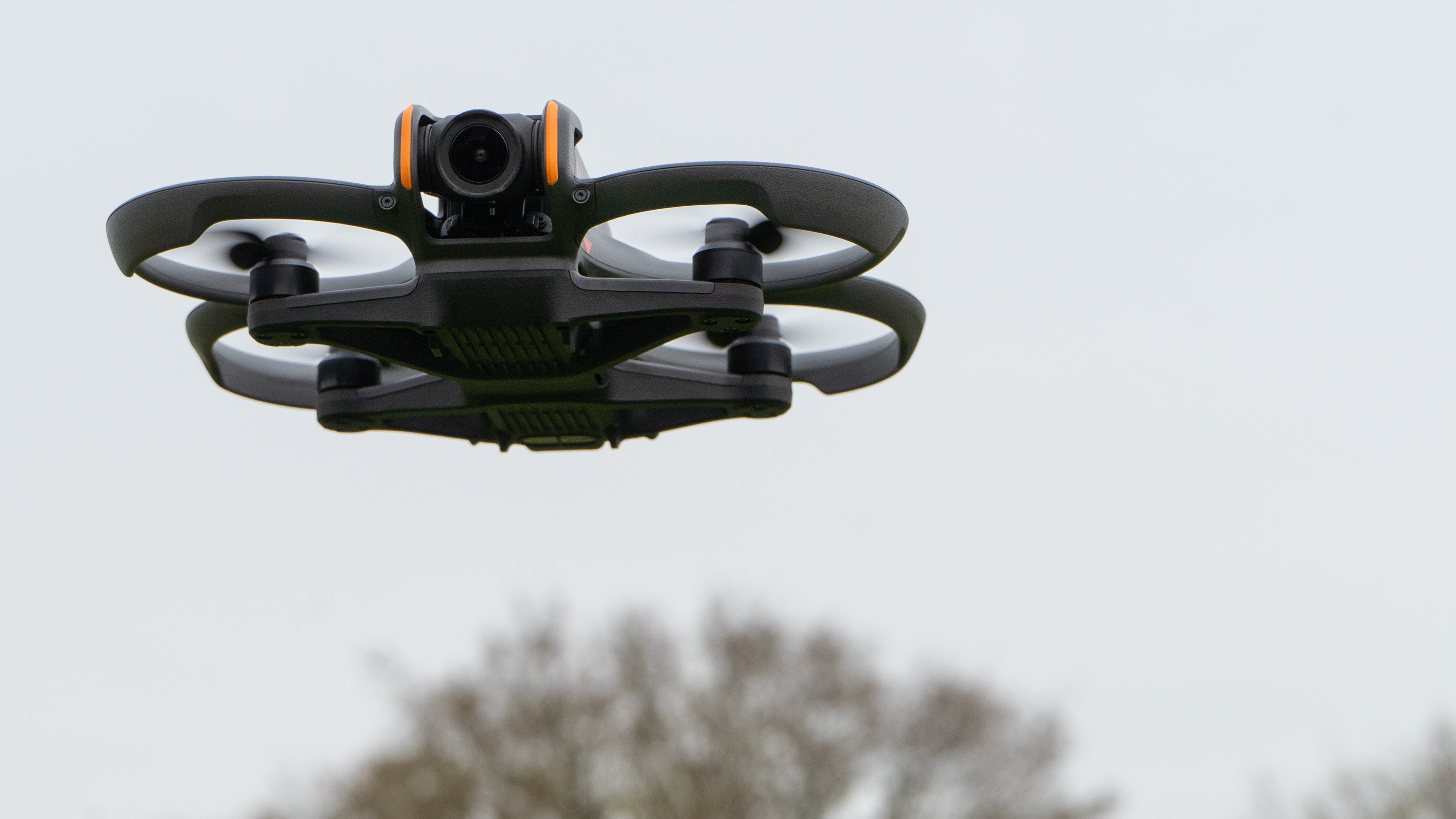
The refinement of every part of the Avata package is significant, including the motion controller. No longer is there any debate to be had about whether this is the right way to control a 'copter. I'm firmly with the side that says this 'wand' (and I was initially a little sceptical), is a brilliant way to open up FPV flying. It is, no doubt, easier than traditional sticks but it is surprisingly precise and very quick to master. You'll be shooting through narrow gaps on your first or second battery, which definitely isn't true of old-school full manual (especially if you can imagine life without simulators).
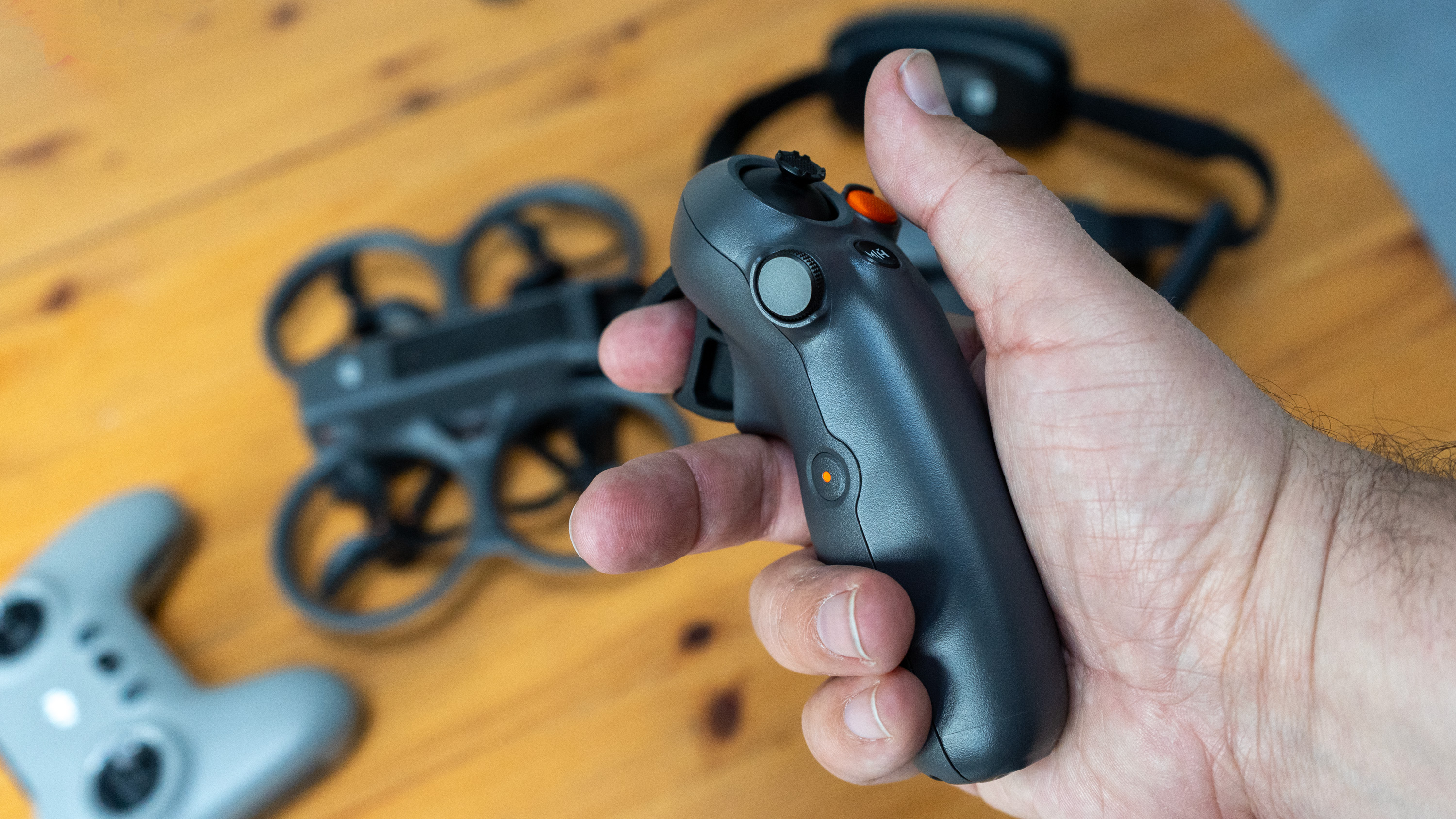
Of course that was largely true of the previous controller, but the new RC Motion 3 fits my right hand like a glove (not sure I can say the same will be true for left-handed pilots). It's smaller and lighter, to the point it felt like part of me.
For example, as you look at it, the camera button seems to sit a bit randomly on the design, but in my hand my middle finger just sat on it perfectly while the thumb was easy reach of the other controls. These have been re-organized, too, so that the thumb can control the joystick where it has most movement, while the buttons are to the right where you have a little less natural movement. It is brilliant.
The new two-stop throttle, operated by the trigger finger, means you only charge forward when you want – no need to reach for a hover button. Again, very natural.
The controller is also now a big part of the operation of the goggles, which have dispensed with the track-pad in favour of a '5D' button or using the RC Motion 3 as a mouse pointer.
FPV Remote Controller 3
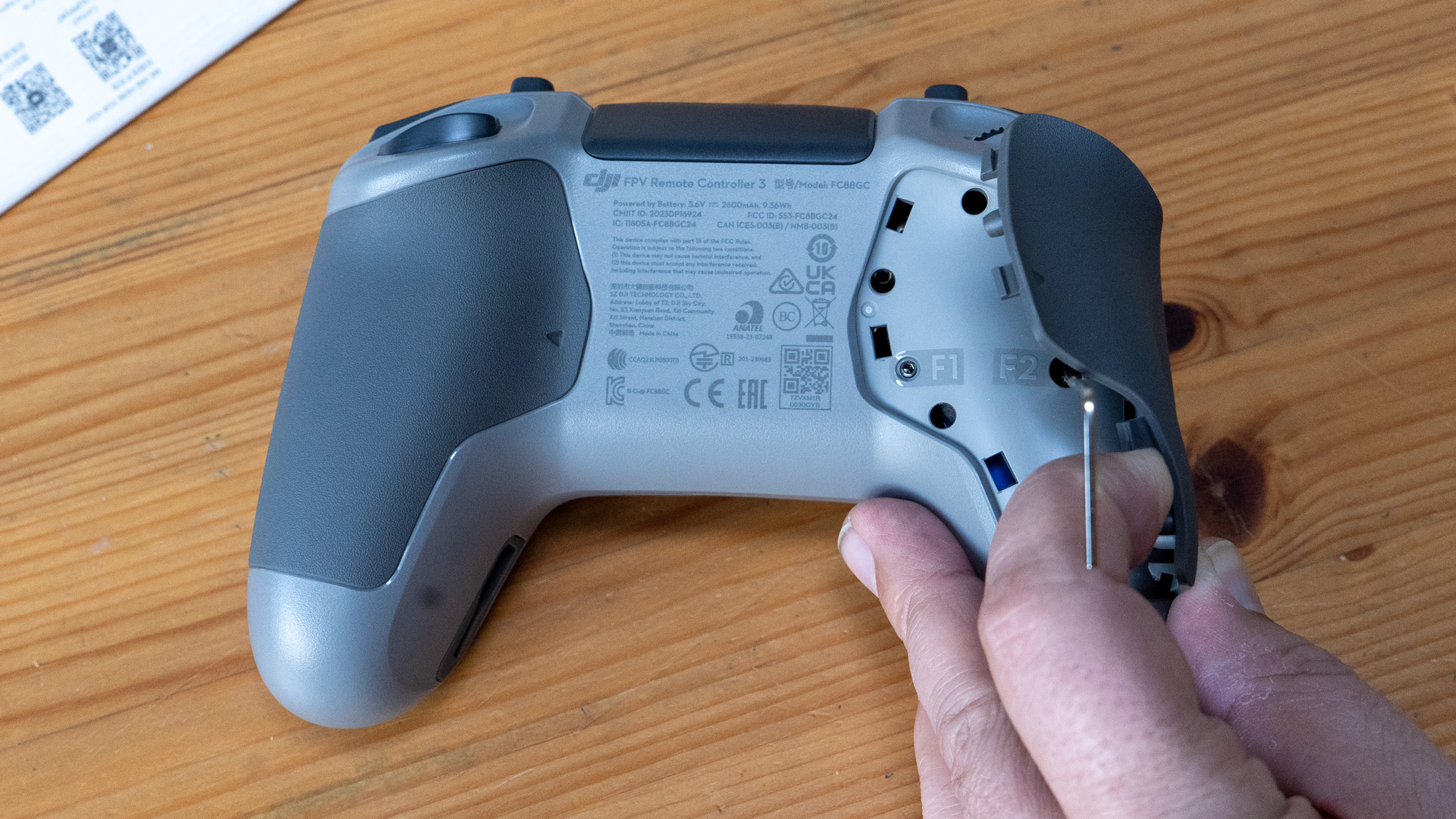
If you do feel like flying the drone in full manual mode, you'll need the FPV Remote Controller 3. This isn't significantly different from its predecessor but, of course, is equipped with the new O4 radio system. That is good enough, it seems, for DJI to ditch antenna, making it look somewhat more like a game controller.
Conceptually, the device is great – a FPV controller with a 'pause' (and even return to home) option right there under your left finger. You can pilot the drone in a similar manner to any other and DJI even provides an alumn key to tweak the disable the spring on the left stick so you can go true manual. While the loss of a stick-up folding antenna certainly didn't cause me any issues in my quite open test area, I found the ergonomics didn't seem suited to the classic 'pinch' grip. If you like the thumb-on-top style then the device is spot on – my thumbs fall ideally for this.
I have to say that there are more than a few serious FPV pilots who have been flying for years who will find this device is what stops them from flying DJI; I don't think the Avata is for them. I won't let it affect my score, but I do sympathise.

DJI Goggles 3
After the controllers and the drone itself, DJI decided one more thing was due for refinement; the goggles. Part of this, no doubt, comes from the need to keep up with the new radio system, but they didn't stop there.
If you've experienced previous DJI Goggles 2, there are a lot of changes to the Goggles 3. For those who have looked enviously at the likes of the Apple Vision Pro, DJI has added binocular (dual) cameras at the front and – with a tap of the side – you can switch to a through view without removing the goggles, which boasts 1080p dual Micro-OLED displays with a broad range of diopter adjustment.
Menu control now comes through a more classic '5D' mini joystick-style button on the top or via the control wand as a pointer, which is easier than you'd imagine to get used to. The goggles also offer head tracking as a means of flight control, which I didn't test.

The headband design now houses a couple of 'lumps', one at the front, one at the back, but no trailing battery. The total weight is 471g (still well under the 600g+ Apple Vision Pro) and there is no trailing battery. The hinge between the top of the goggles and the housing itself means the weight is gently spread over your forehead and can be tweaked to suit, well, I assume most heads – certainly when I adjusted it correctly it seemed to lift all the weight off the bridge of my nose.
Admittedly the 3D pass-through view is limited. In daylight (or as close as we get in the UK) it was OK, but it does look a bit odd and the software won't allow it with other features like picture-in-picture. In low light the overlaid noise is surreal, but you can of course turn it back to 2D (which is where it was set by default interestingly despite DJI adding two cameras).
While the comfort was great, I could I didn't have a lot of use for the pass-through because tapping on the side didn't seem to work well for me. Perhaps the motion sensing which (presumably) triggers this mode will be refined in a firmware update but, for now, it wasn't as reliable/natural as I'd hope.
Performance
For me, the drone flew like a dream in conditions that, frankly, it shouldn't have. That is, admittedly, until I ventured into acro (full manual) control – but we'll get to that.
Because the weather was not my friend in my testing period, I had to contest with fairly strong gusts. I started cautiously, but luckily, it was not too much for the quad, especially near the trees. Combing back to the Avata after a while meant I appreciated the tutorials the DJI built-in, but there is nothing like the real thing, so I took off in beginner mode and the drone was steady as a rock.
DJI claim a theoretical 23-minute flight time but, if you're having any fun, you won't get anything close to that – the constant changes and demands for maximum power on the battery are hard work, less efficient than a typical camera drone, and the harder you fly, the more stunts you do, the less relevant those theoretical numbers are.
Switching to normal I was away and I cannot explain how quickly I felt like I'd been doing this my whole life. The motion controller seemed to disappear into me and the response to turns and the two-stage trigger feel so natural it's hard to describe the mechanics.
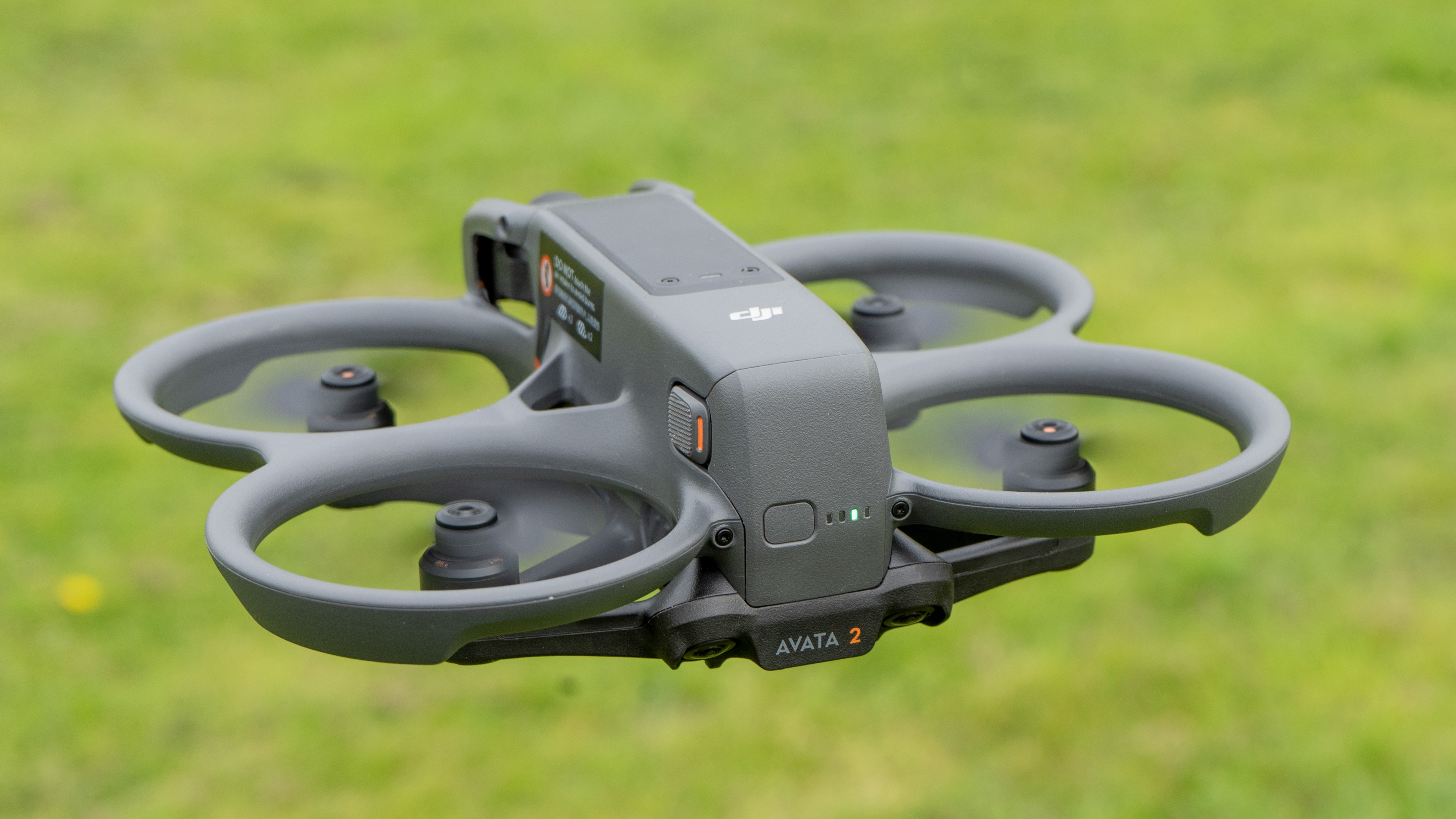
The 2-axis gimbal provides very smooth visuals – the rest of the image stabilization comes from the magic of digital and having such a wide field of view. There is a new algorithm – EIS 3.5 – controlling the stable image and it coped incredibly well with the wind I tested in, where I measured gusts at ground level approaching 30mph.
Cinematographers can take advantage of image stabilization and horizon-matching stabilization, just like the OSMO Action cameras.
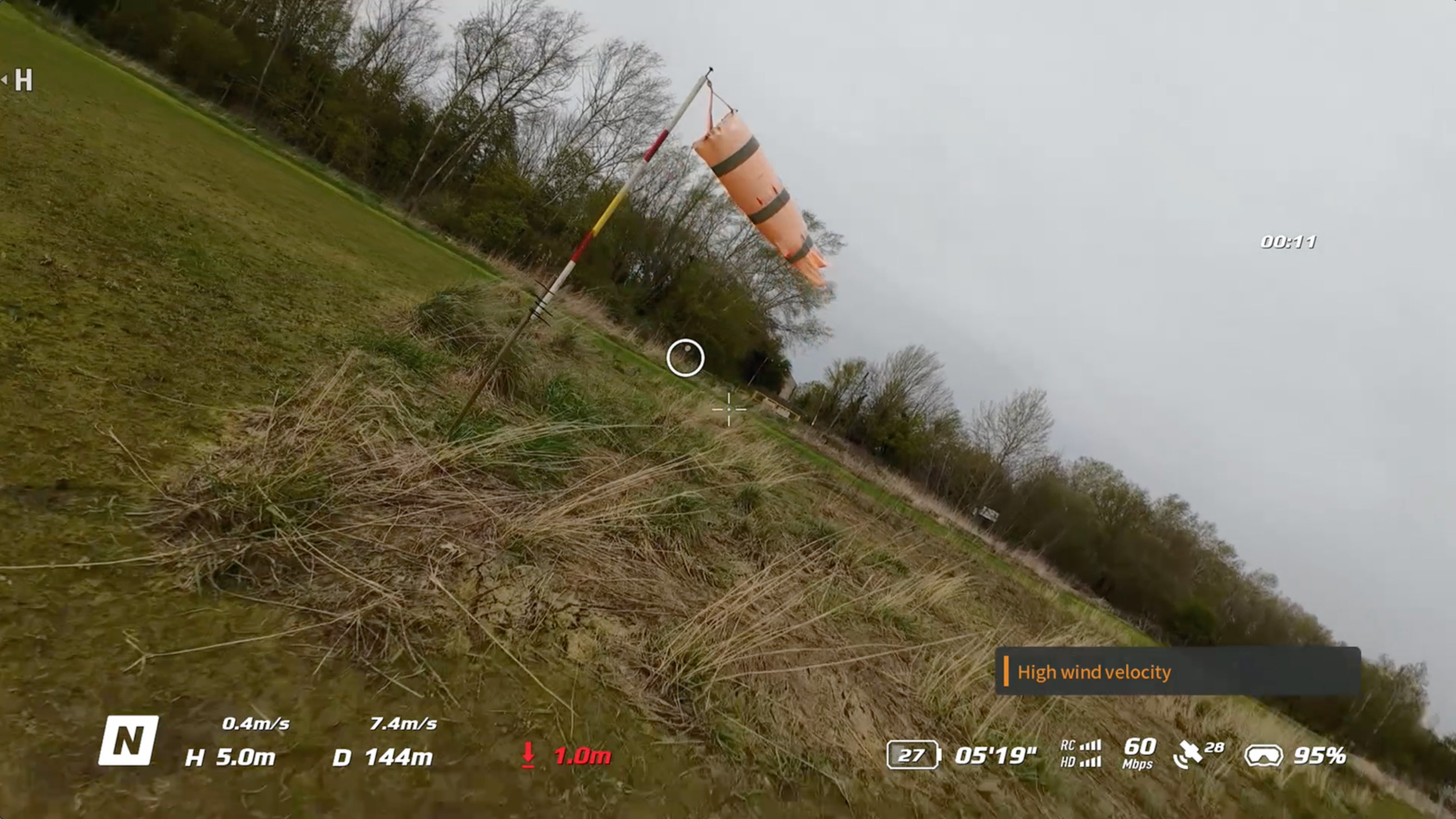
With the goggles on it is tricky to understand what angles the 'copter itself might be adopting to pull of the turns you're demanding, let alone how the software is coping with the wind, but my confidence grew so fast that I was soon able to plan a slightly cheeky test of the airframe's strength – to clip the side of a tiny tree.
I'd done this with the Avata and it brought the drone down. It was OK, but I had to traipse love the field to get it. This time, however, while the impact was obvious and the camera needed a landing to reset it, the drone didn't lose. I was in fact able to order the drone to use GPS to come back to me or operate it 'old school' (line of sight'). Had it crash-landed belly up the drone also has the ability to flip itself – turtle mode – handy!

Something I genuinely didn't expect to say was that the Avata 2 is quieter. The switch to 3-blad props is visible but clearly other refinements have played a part in keeping the noise down and this is notable. Personally I wasn't totally happy about this – I love the rip-and-burn noise FPV props make – but DJI point out that this can be disturbing to others and that is palpably reduced here; it says 81Db on the outside though I wasn't able to hold my decibel tester in the air!

After an ill-advised attempt to fly full manual with the Remote Controller 3 despite the wind (and, to be fair, the drone was giving me a warning about the wind on screen), I hit the ground – a bit harder than my 'branch test'. This still caused no problems with the hardware. Very rugged! The airframe did pick up a few bits of grass though – it was fairly recently cut, and I suspect I cut some freshly with the props too! I did find some bits a little tricky to clean out in the field with just fingers – it seemed to get near the vents. FPV fans do say you should fly over longer grass – perhaps that's why!
DJI Avata 2 Sample Video
Sadly the weather isn't all that, so I need to test in a fairly open environment, but the drone performs well. You'll see it even copes with a small branch test – better in fact than the Avata 1 did as it was able to keep flying.
DJI Avata 2 Sample Images

Overall Verdict
The Avata 2 gets a near-perfect score from me because, value aside, there is very little to complain about. This is a very well-built and rugged drone (and I really tried that to the limits!) It offers more than you might expect in terms of quality, so it's an ideal extra shooting option for a drone operator looking for the kind of shot a normal camera drone just won't give as well as an exciting device.
The RC Motion 3 is part of the brilliance too; this means of control seems to have reached the point of bionic convergence. The new size, shape and addition of a two-step throttle are matchless in their simplicity and accuracy. Some will no doubt complain that the automated stunts are a gimmick but, hey, no one likes it when AI can do their job!
As a package, too, everything largely just works once you follow the steps to connect devices. Sure, there is a degree of learning needed – but there should be if you're new to FPV, it's a new hobby or sub-hobby. My chief issue with the Goggles 3 was that – when tapping on the side to initiate the pass-through I found I ended up nudging the goggles which seemed to defeat the object of visual pass-through slightly. If this could be made more consistent, that'd be my main complaint gone.
I would caution you not to buy the drone with a single battery unless you absolutely can't afford to buy three at once. Remember your flight time at a location is limited when you start to enjoy (and enjoy you will) the manoeuvrability, you'll use a battery fast (and it'll seem even faster because it's fun). You'll want the spares.
| Features | Near-perfect drone and control system open FPV up for beginners and 'ordinary' drone users | ★★★★★ |
| Design | Much-improved design makes life easier | ★★★★★ |
| Performance | Wonderful radio performance and excellent imaging | ★★★★★ |
| Value | This is noticeably more expensive than many DJI drones, and if you need value the original is a consideration (at least for now). | ★★★★ |
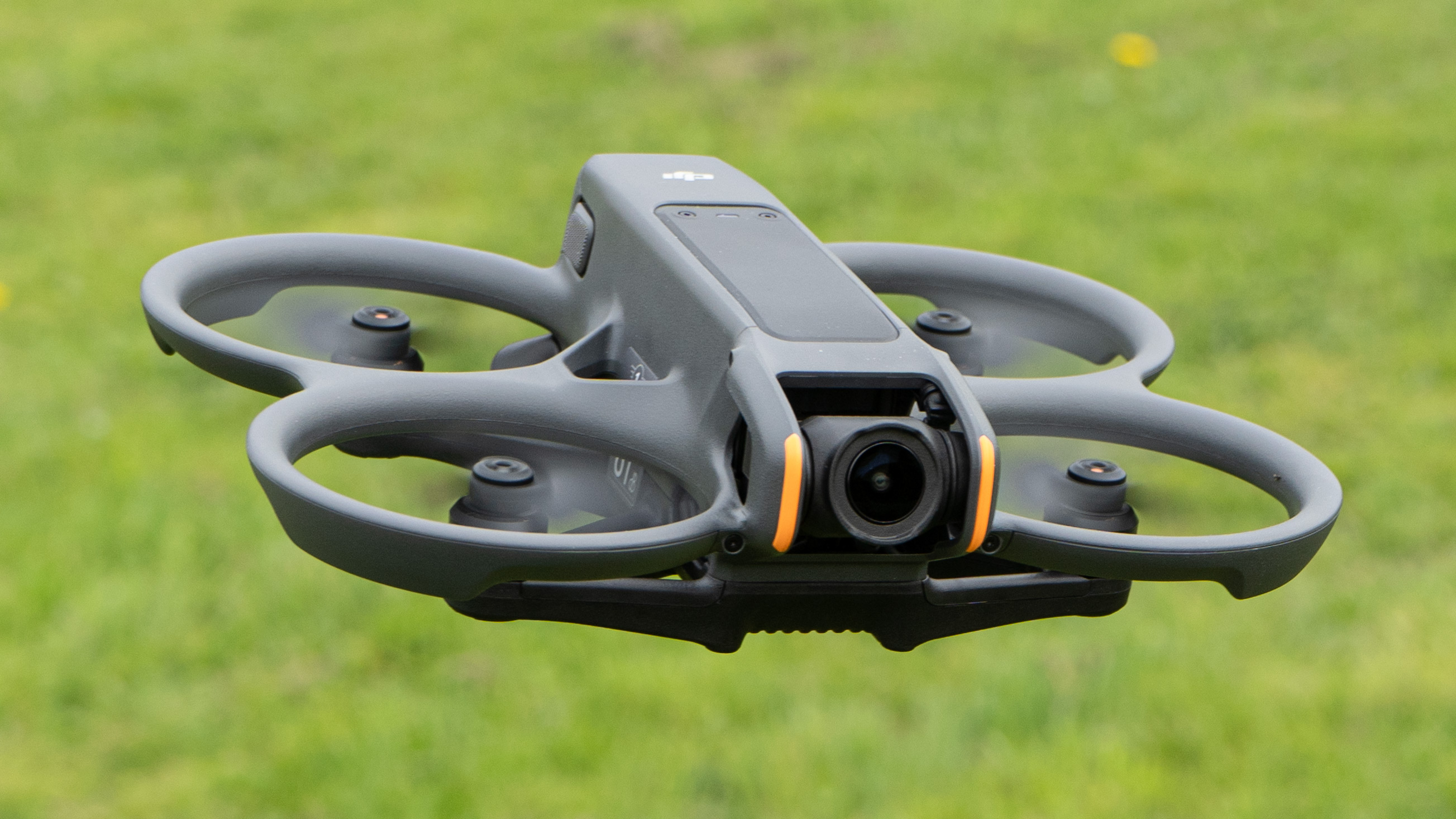
Should you buy the DJI Avata 2?
✅ Buy this if...
- If you want a top-quality FPV drone that lets you capture stunts and feel close to the sky.
- You're looking to take stunning videos flying from wide panoramic views through windows and buildings.
- You've always loved the look of FPV but don't have the patience or inclination to get 'into the hobby' and want to start with an accessible device.
🚫 Don't buy this if...
- You want a drone for sweeping, hovering establishing shots.
- You are looking for the cheapest way to experience FPV flying
- You're a longstanding FPV enthusiast; if you've mastered stick control then DJI's ergonomics are odd and the RC Motion is better suited to welcoming new enthusiasts than established ones.
Alternatives
The Beta Cetus X FPV is the device to try if you're looking for a cheap and relatively risk-free way way to experience FPV flying. It won't take images of the same quality, but its a great way to try FPV for a lot less.

With over 20 years of expertise as a tech journalist, Adam brings a wealth of knowledge across a vast number of product categories, including timelapse cameras, home security cameras, NVR cameras, photography books, webcams, 3D printers and 3D scanners, borescopes, radar detectors… and, above all, drones.
Adam is our resident expert on all aspects of camera drones and drone photography, from buying guides on the best choices for aerial photographers of all ability levels to the latest rules and regulations on piloting drones.
He is the author of a number of books including The Complete Guide to Drones, The Smart Smart Home Handbook, 101 Tips for DSLR Video and The Drone Pilot's Handbook.
